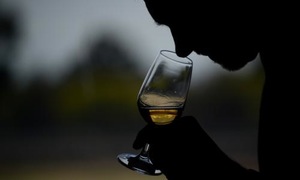
The overall alcohol consumption of Australians is at its lowest level since the 1960s, data released Wednesday by the Australian Bureau of Statistics show.
When all alcoholic categories were considered, which includes wine, beer, cider, spirits and ready to drink, there were 9.7 litres of pure alcohol available for consumption in 2013-14 for every person in Australia aged 15 and over.
Data across all categories has been recorded since 1960-61, and shows alcohol consumption peaked in 1974-1975, when there were 13.09 litres of pure alcohol available per person, the Apparent Consumption of Alcohol report also shows.
The most recent decline in consumption began in 2007-2008, dropping each year since then.
The bureau’s director of health statistics, Louise Gates, said the types of drinks consumed had also changed.
“Fifty years ago, beer made up three-quarters of all alcohol consumed, but now makes up under half at 41%,” she said.
“Wine’s share has increased over the same period from 12% to 38%”
Australians consumed more white wine than red wine in 2013-2014, at 270m litres and 190m litres respectively, while full-strength beer was the most popular type of beer, accounting for around three-quarters of all beer consumption.
Australian Liquor Stores Association chief executive, Terry Mott, said the figures showed there was no alcohol epidemic, and that Australians were more educated about responsible drinking of alcohol than ever before.
“Australians are drinking less in terms of quantity but of a better perceived quality,” Mott said.
“This has led to the rise in craft beer and cider across the country with more people visiting cellar doors, boutique distilleries and breweries to appreciate the quality of the artisanship… and not the just the alcohol.”
But Dr Nadine Ezard, the clinical director of the Alcohol and Drug Service at St Vincent’s Hospital in Sydney, said alcohol-related harm remained one of the nation’s biggest social and health challenges.
Every day 430 Australians were hospitalised due to alcohol consumption, she said, and alcohol was second only to tobacco as the leading preventable cause of death and hospitalisation.
“This is general population data, and it shows a period of relative stability in alcohol consumption over the past 20 years, at a time when we’re seeing increases in alcohol-related harms,” Ezard said.
“Some are drinking too much and and at harmful levels, and we need more information broken down by sub-population to better identify who those people are.
“It’s like if you averaged out the weather for all of Australia, it wouldn’t necessarily give you a realistic idea of what’s going on in Melbourne or Sydney.”
The cost of alcohol-related harm in Australia including hospitalisations, child protection and loss of productivity was estimated at around $20bn each year, she said.
“To reduce alcohol-related harm we need to decrease the availability of alcohol through restricting outlet density and trading hours, place stronger restrictions on alcohol marketing and a volumetric tax on alcohol,” she said.
“Money from that tax should then be redirected into treatments.”
